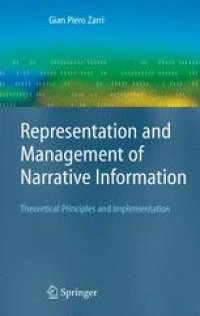
Ebook: Representation and Management of Narrative Information: Theoretical Principles and Implementation
Author: Gian Piero Zarri (auth.)
- Tags: Artificial Intelligence (incl. Robotics), Models and Principles, Information Systems Applications (incl.Internet), Information Storage and Retrieval, Language Translation and Linguistics, Multimedia Information Systems
- Series: Advanced Information and Knowledge Processing
- Year: 2009
- Publisher: Springer-Verlag London
- Edition: 1
- Language: English
- pdf
A big amount of important, economically relevant information, is buried within the huge mass of multimedia documents that correspond to some form of ‘narrative’ description.
Due to the ubiquity of these narrative resources, representing in a general, accurate, and effective way their semantic content – i.e., their key ‘meaning’ – is then both conceptually relevant and economically important. This book presents the main properties of NKRL (‘Narrative Knowledge Representation Language’), a language expressly designed for representing and managing, in a standardised way, the meaning of complex multimedia narrative documents. NKRL is a fully implemented language/environment that exists in two versions: a relational database-supported version and a file-oriented one. It constitutes probably the most complete and realistic effort realised so far to deal with the huge industrial potentialities of the narrative domain.
Written from a multidisciplinary perspective, this book not only supplies an exhaustive description of NKRL and of the associated knowledge representation principles, it also constitutes an invaluable source of reference for practitioners, researchers and graduates in domains that range over narrative theories, linguistics and computational linguistics, artificial intelligence, knowledge bases, information retrieval, ontologies and the semantic Web.
A big amount of important, economically relevant information, is buried within the huge mass of multimedia documents that correspond to some form of ‘narrative’ description.
Due to the ubiquity of these narrative resources, representing in a general, accurate, and effective way their semantic content – i.e., their key ‘meaning’ – is then both conceptually relevant and economically important. This book presents the main properties of NKRL (‘Narrative Knowledge Representation Language’), a language expressly designed for representing and managing, in a standardised way, the meaning of complex multimedia narrative documents. NKRL is a fully implemented language/environment that exists in two versions: a relational database-supported version and a file-oriented one. It constitutes probably the most complete and realistic effort realised so far to deal with the huge industrial potentialities of the narrative domain.
Written from a multidisciplinary perspective, this book not only supplies an exhaustive description of NKRL and of the associated knowledge representation principles, it also constitutes an invaluable source of reference for practitioners, researchers and graduates in domains that range over narrative theories, linguistics and computational linguistics, artificial intelligence, knowledge bases, information retrieval, ontologies and the semantic Web.
A big amount of important, economically relevant information, is buried within the huge mass of multimedia documents that correspond to some form of ‘narrative’ description.
Due to the ubiquity of these narrative resources, representing in a general, accurate, and effective way their semantic content – i.e., their key ‘meaning’ – is then both conceptually relevant and economically important. This book presents the main properties of NKRL (‘Narrative Knowledge Representation Language’), a language expressly designed for representing and managing, in a standardised way, the meaning of complex multimedia narrative documents. NKRL is a fully implemented language/environment that exists in two versions: a relational database-supported version and a file-oriented one. It constitutes probably the most complete and realistic effort realised so far to deal with the huge industrial potentialities of the narrative domain.
Written from a multidisciplinary perspective, this book not only supplies an exhaustive description of NKRL and of the associated knowledge representation principles, it also constitutes an invaluable source of reference for practitioners, researchers and graduates in domains that range over narrative theories, linguistics and computational linguistics, artificial intelligence, knowledge bases, information retrieval, ontologies and the semantic Web.
Content:
Front Matter....Pages i-x
Basic Principles....Pages 1-37
The Knowledge Representation Strategy....Pages 39-101
The Semantic and Ontological Contents....Pages 103-181
The Query and Inference Procedures....Pages 183-243
Conclusion....Pages 245-250
Back Matter....Pages 251-301
A big amount of important, economically relevant information, is buried within the huge mass of multimedia documents that correspond to some form of ‘narrative’ description.
Due to the ubiquity of these narrative resources, representing in a general, accurate, and effective way their semantic content – i.e., their key ‘meaning’ – is then both conceptually relevant and economically important. This book presents the main properties of NKRL (‘Narrative Knowledge Representation Language’), a language expressly designed for representing and managing, in a standardised way, the meaning of complex multimedia narrative documents. NKRL is a fully implemented language/environment that exists in two versions: a relational database-supported version and a file-oriented one. It constitutes probably the most complete and realistic effort realised so far to deal with the huge industrial potentialities of the narrative domain.
Written from a multidisciplinary perspective, this book not only supplies an exhaustive description of NKRL and of the associated knowledge representation principles, it also constitutes an invaluable source of reference for practitioners, researchers and graduates in domains that range over narrative theories, linguistics and computational linguistics, artificial intelligence, knowledge bases, information retrieval, ontologies and the semantic Web.
Content:
Front Matter....Pages i-x
Basic Principles....Pages 1-37
The Knowledge Representation Strategy....Pages 39-101
The Semantic and Ontological Contents....Pages 103-181
The Query and Inference Procedures....Pages 183-243
Conclusion....Pages 245-250
Back Matter....Pages 251-301
....